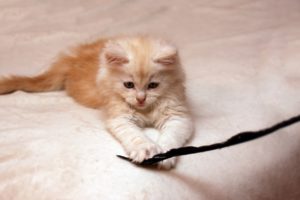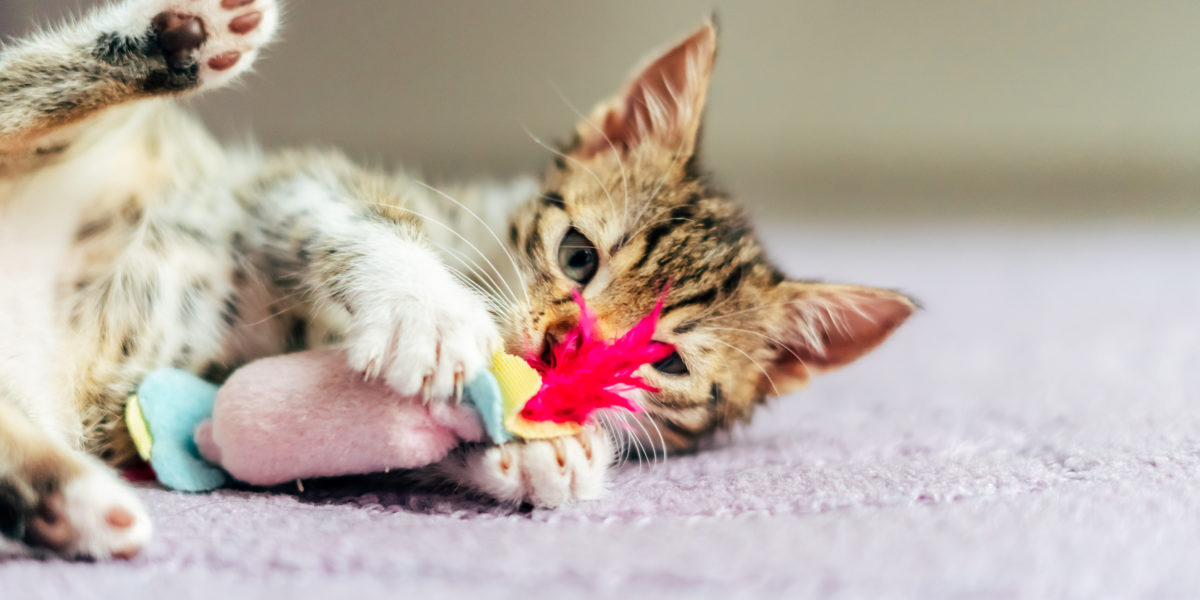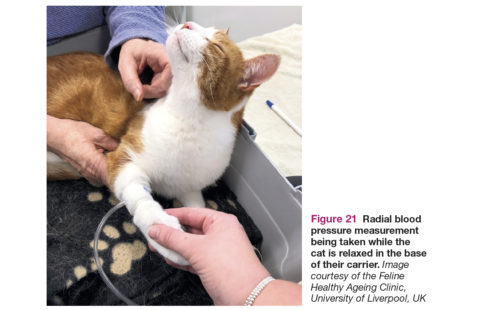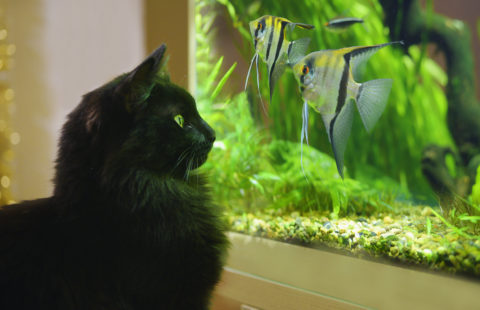International Cat Care are partnered with The British Veterinary Nursing Association (BVNA) as the BVNA’s chosen charity. In this new series, BVNA president Alex Taylor will be writing articles for our blog aligned to our monthly social media themes. This month is ‘Kittens’, read on for Alex’s top tips for playing with kittens.
Kittens are a lot of fun, and it’s important that playtime is stimulating for them but safe for all involved. Playing mimics hunting behaviours in cats and kittens, making it an excellent way for them to engage in natural predatory behaviour and use up energy. Interactive play can also help create a positive bond between an owner and a kitten. Here are some top tips on how to encourage appropriate play in kittens:
Never use your hands or feet to play with a kitten. Although this is tempting and seems cute at first, it can lead to serious problems in the future as the kitten matures. This is because the kitten will start to associate fingers and toes with playtime, but as it grows bigger and stronger and play becomes more intense, its growing teeth and claws can cause pain and injury.
Cats and kittens are attracted to fast movements, so activities like wiggling your fingers in their line of vision or moving your feet around under the duvet can be amusing at first. They will likely catch your kitten’s attention and trigger a stalking and pouncing response. However, this type of interaction should be avoided as it can cause misdirected predatory play toward humans in the form of ambushing, which can result in serious injury.

Kittens learn to play in different ways, including object play (toys), social play (between two littermates or kittens) and locomotor play (climbing). Cat owners can provide kittens with toys for object play, which can be fun for the kitten as it gets to bat, toss, grab, bite and chase the toy. Toy mice, fish, ping-pong balls, bottle tops, feathers and scrunched up foil or paper can all be used for object play – but kittens should be supervised at all times to make sure they do not ingest any hazardous materials.
Kittens may prefer some toys over others, depending on the size, texture, smell, and noise the toy makes, as well as how fast it moves when batted. Some kittens also enjoy larger soft toys that they can rake and kick with their back legs. Pipe cleaner toys should be avoided as they can be sharp and could cause trauma if ingested. Care should also be taken with toys made of ribbons or string, as well as balls of wool. These can be problematic as they can cause the kitten’s intestines to become bunched up if eaten (intussusception), resulting in the need for emergency veterinary care and surgery.
Catnip toys may not be very effective at encouraging kittens under three months of age to play, as they are not responsive to catnip before this time (keeping in mind that around one-third of cats are not responsive to catnip at all). However, older kittens can respond well to catnip, so it is worth offering it again if the kitten showed no interest in its first few months, as catnip can help initiate play.
Interactive play with kittens can be a lot of fun for kittens and their owners. Wand or fishing rod toys are good choices because they keep some distance between you and the kitten, which can help prevent accidental scratches or bites. Wand toys are particularly useful when teaching children to play with cats, but this should always take place under close supervision, especially with young children.
Wands with toy mice, feathers, or toy worms attached may be particularly attractive for kittens to play with and can be moved across the floor at different speeds to catch the kitten’s eye and initiate play. Interactive playtime can be even more stimulating for the kitten if boxes or tunnels are used to pull the toy through or around.

Play may only last for a few minutes, as kittens may become bored and tire easily. However, this can very much depend on the kitten, so if you want to end a playtime session the game should end gradually, and the kitten’s attention directed onto something else (e.g. some food). This will help prevent frustration and ambushes onto humans or other pets in the household. Care should be taken to never leave a kitten unsupervised with a wand toy, as they could become caught up or injured.
It is possible to puzzle feed kittens from as early as twelve weeks, and this can provide a stimulating and interesting alternative way for kittens to access their food. It’s best to start with a very simple puzzle feeder, such as an open egg box with kibble placed inside, or a very basic slow feeder.
Kittens and cats can become easily bored with toys, so be sure to rotate them to maintain interest. Remember that although some adult cats may seem to be less playful than kittens, they can also benefit from regular playtimes, even if they have access to the outside.
For more information on playing with your kitten or cat go to: https://icatcare.org/advice/playing-with-your-cat/
BVNA is the representative body for veterinary nurses. They promote the interests of veterinary nurses, and prepare their members for the challenges ahead. To find out more, visit https://bvna.org.uk/






